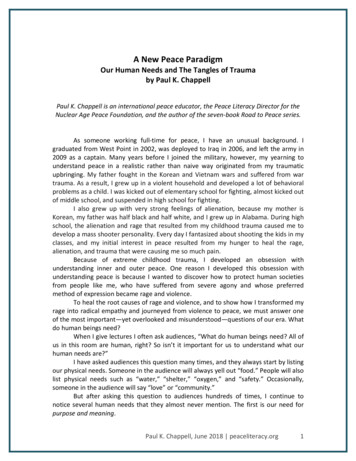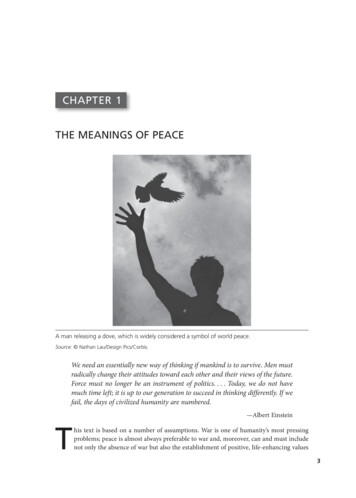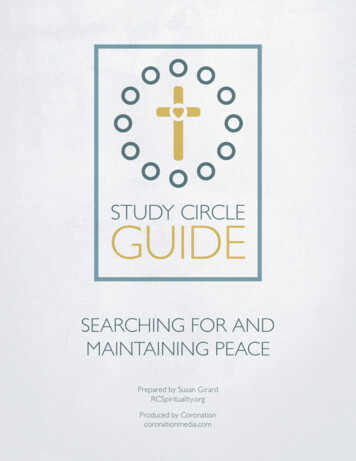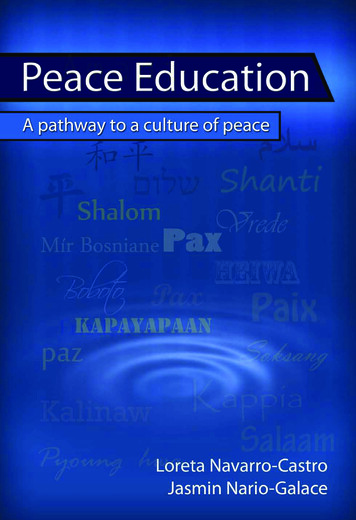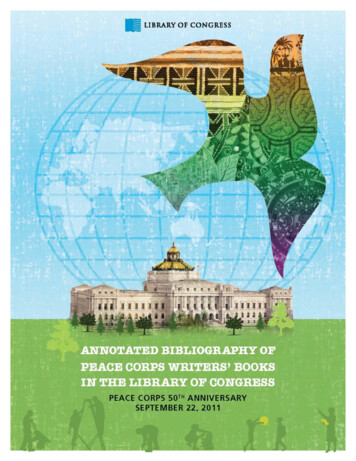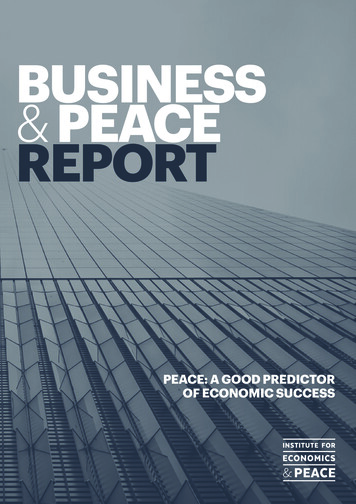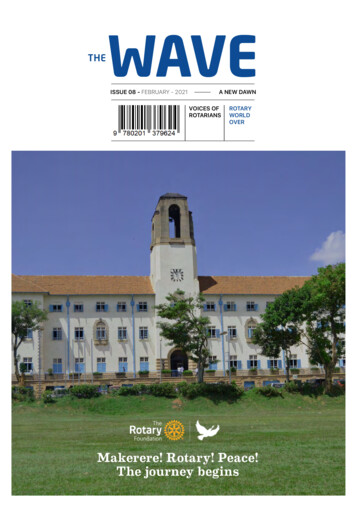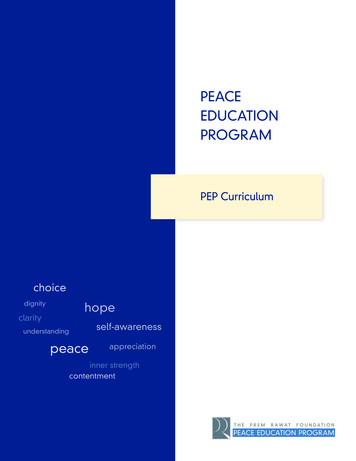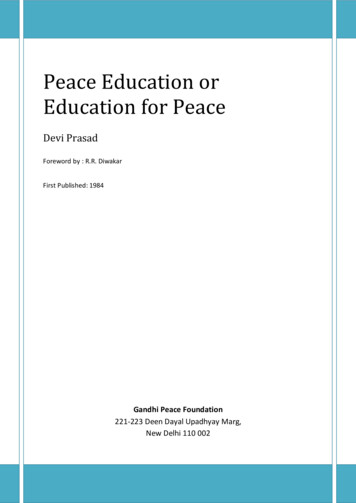
Transcription
Peace Education orEducation for PeaceDevi PrasadForeword by : R.R. DiwakarFirst Published: 1984Gandhi Peace Foundation221-223 Deen Dayal Upadhyay Marg,New Delhi 110 002
Peace Education or Education for RT ONEPEACE EDUCATION—an overview1. PEACE RESEARCH2. TRAINING FOR PEACE AND NONVIOLENCE: RESOURCE MATERIAL2.1. Training Manuals2.2. Handbooks and other publications2.3. Movement journals and newsletters2.4. Audio-visual material3. PEACE EDUCATION AND THE POPULAR PRESS4. PEACE GROUPS OF PROFESSIONALSThe B.M.A. Report5. THE UNITED NATIONS AND DISARMAMENT6. PACIFIST AND NONVIOLENT MOVEMENTS6.1. Pacifist movements and the growth of anti-militarism6.2. The anti-nuclear movement6.3. The nonviolent movement in India7. PEACE AND THE ENVIRONMENT8. PEACE AND NUCLEAR ENERGYRadio activityNuclear WasteSUMMARY 0F PART ONEWhat could this breakthrough be?PART TWOEDUCATION FOR PEACE—a thesisConclusionREFERENCESAPPENDICES1. BibliographyPeace journals—a selected list2. Peace Organisations—a selected listwww.mkgandhi.orgPage 1
Peace Education or Education for PeaceACKNOWLEDGEMENTI am thankful to those friends of mine who had sent their comments andsuggestions after reading the original essay Peace Education or Education forPeace, which was published in some peace journals a couple of years ago. Manyof those comments have helped me in developing the theme further. Last yearSri R.R. Diwakar went through the paper and gave me a written note pointingout some of the gaps, which I knew were there, but had felt too lazy to rewrite the paper in the same form. When Sri Radhakrishna read it he suggestedthat I should expand it and make it into a book, which the Gandhi PeaceFoundation could publish. I am thankful to both of them to induce me topresent my thesis in this form.Throughout the course of writing, first the original essay, and then the book,my wife Bindu Prasad continued helping with ideas, comments and informationrelevant to the subject of special education. She has also assisted in preparingthe typescript of the bibliography and the list of peace organisations. It wouldhave been difficult for me to complete the work without all the help she gaveso lovingly. My very special thanks to D. Dalip who put in so much of his time ingoing through the manuscript, reading proofs and preparing the sketches andthe lay-out of the book including the cover. Thanks also to Rita Roy for herhelp in proofreading. Diwakarji has been very kind to agree to write theForeword, for which I am grateful to him.Hiroshima DayAugust 6,1984www.mkgandhi.orgDevi PrasadPage 2
Peace Education or Education for PeaceFOREWORD'Peace Education or Education for Peace’ is a two-fold title for this small bookon a very big problem, in fact the biggest before mankind today.The author deals with two aspects of the problem. Under 'Peace Education* hedeals with several disciplines, training and efforts which people dedicated toworld peace have been adopting to combat the menace of war, absence ofpeace and socio-economic evils—ethnic, religious or cultural, and which oftenleads to violence and destruction of people and property.The author has been active in opposing war. He has enriched the book with awealth of detail which has never been brought together in this way. Here wehave the pacifists who turned conscientious objectors against all kinds of war;we have those who trained themselves as nonviolent resisters to socioeconomic evils in society; we have information on training and discipline of thesatyagraha movement in India initiated by Gandhi; and a bibliography. Thereare also interesting details on how people were deluded into believing thatthey could escape the disasters if they build underground shelters.The quality, the amount, and the varieties of information regarding the deadlyeffects of nuclear war, which have been flooding the mass media are enough toconvince even a blockhead that there is no real remedy against its annihilatingeffects, and that prevention of such a suicidal war is the only effectiveremedy. It is suicidal because such a war is 'unwinnable'; as neither the victor,nor the vanquished will survive, as this kind of violence has lost its 'survivalvalue' altogether.Warnings against its disastrous effects were given by Einstein in his five-lineletter to President Roosevelt. Dr J. Robert Oppenheimer had qualms ofconscience even as he was on the job of manufacturing the 'Little Boy' whichkilled in a split second 70,000 inhabitants of Hiroshima on 6th August 1945 andthe 'Fat Man' which devastated Nagasaki three days later. But instantwww.mkgandhi.orgPage 3
Peace Education or Education for Peacedestruction apart, by 1983 more than two thousand Japanese victims had diedof its after-effects. Its genetic effects have yet to be investigated.On the eve of President Truman's fatal decision in 1945 to use the atomic bomb32 scientists presented a signed document not to use the bomb at all on nonmilitary targets and if used on a military target, never to use it without givingprior warning.It was hardly realised that the whole question of war and peace betweennations had undergone a sea-change. As the British Prime Minister ClementAtlee put it in his letter to Truman on 25th Sept., 1945, that the atom bombhas meant not a quantitative but a qualitative change in the nature of warfare,and that it was more destructive than anything the world had previouslyknown. Even after 39 years, we have no effective defence either, and thecapability of atomic weaponry is not the privilege of only one or two but fivePowers. Its know-how is supposed to be with 35 nations.With all the inventiveness of man and the mighty strides in science andtechnology no effective defence has yet been found. Like the 'fireextinguisher', there is no 'bomb extinguisher' in sight! Politicians responsible forrunning governments of countries do not educate their people about thequalitative change in the nature of war. Instead, they are going ahead withmore and more nuclear tests and with the arms race. Both, the politicians andthe people are being deluded into seeking peace in what is called 'deterrence',similar to the old-time jargon called 'balance of power'. This is in spite of awarning given by the former U.S. Defence Secretary McNamara that in the"name of deterrence the big powers are walking straight into a deathtrap.The tragedy of the world situation and of the four-and-a-half billion peopleinhabiting this earth is that the arms race is going on with the full knowledgeof its consequences on account of the logic of the power-struggle. Since theremedy cannot be found in the external situation which is a logicalconsequence of the mutual fear and distrust within the political powers whoare competing for ruling over the whole world, it has to be found in the mindsof men and women and children whose very existence is at stake.www.mkgandhi.orgPage 4
Peace Education or Education for PeaceIn the second part, the author puts emphasis on education for peace—for peaceof mind; peace in the family, peace in society and peace between nations.Peace within the borders of a nation has been vouchsafed by vesting themonopoly of violent sanction in the Nation-State. It was sought to do the same(theoretically) through the United Nations Organisation by those powers whowere the victors in the Second World War. But it has proved an abortiveattempt. Although the emblem, they said, was 'to beat swords intoploughshares', it has become petrified into a beautiful sculpture at the HeadQuarters of the U.N. It has now remained only a copy-book maxim. One-worldgovernment or a federation or free nations would perhaps be a solution!It is in this area of thought and action that the educationist in the author ofthis book has a full play. Is there something tragic within the mind of thehuman being that drives him to aggression and violence? It is true that man hasnot yet cared to build a value-system which could guide his steps in using,instead of abusing, science and technology. It is not too late for the innerapparatus of man—his consciousness—to create a value-system which would usehis energies only constructively.Man is not only conscious but is self-conscious too, and he knows that he is so,and can therefore be a witness to what is going on in his consciousness. He hasalso developed a conscience, a kind of judgement centre for creating values.It is his privilege to strengthen his will to stick to and promote values that heknows can take him to higher and nobler levels of consciousness, giving him asense of fulfilment and perfection.Gandhi was one of the foremost path-finders in this respects. Faced, as man is,with constructive and destructive forces in himself and in nature, love andhate, life and death, health and disease, joy and sorrow, man ought to allyhimself with constructive forces. The positive and negative elements, thepassions for good as well as evil are there in the known and unknown regions ofthe consciousness of man. It is for man, the moral being that he claims to be,to promote positive, life- giving and progressive urges without giving anyleeway to the negative ones.www.mkgandhi.orgPage 5
Peace Education or Education for PeaceNor is. there any scope for man to despair when the scene seems to be so darkFor, even a cursory glance at the sociology of homo, sapiens reveals thatmillennia after millennia man has progressed from the stage when only a few innumber lived in caves to over four billions now spread over in one hundred andsixty organised nations, with a United Nations he himself has created. It giveshope that the positive forces have proved their survival value.Education for peace, therefore aims at promoting the positive urges in mansuch as search for truth, love, friendliness, cooperation, harmony and so on.We should be equally careful to see that urges which drive one to destroy andharm others are curbed and substituted by positive urges.The book is obviously a work by a confirmed peace worker and who has to hiscredit an activist career in the field of world peace and a rich experience inGandhi's educational experiments. This book is a good contribution both in thefield of Peace Education and Education for Peace.R.R. DIWAKARwww.mkgandhi.orgPage 6
Peace Education or Education for PeaceINTRODUCTIONIn the summer of the year ninteen-eighty-two I was asked to give a talk onpeace education at a conference in London. The organisers of the conferencemust have thought that as one who had some first-hand experience of theinternational peace movement, I'd be able to inform the conference on theactivities of the various groups in different parts of the world working toeducate their own constituencies on the horrors of war and the arms race,particularly of nuclear armaments. They may have been of the view that suchinformation might strengthen their anti-war convictions and motivate them todo more to oppose their government's policies, and to influence others to dothe same.I accepted the invitation for two reasons. One, I had been in touch with someof the material being produced by peace education wings of many peaceorganisations and also with some special groups that had been set up to doinvestigations, in the field of nuclear weapons and their effects —social,economic and medical. Some groups were specifically working to providematerial for the use of teachers in schools. Much of this material, I knew, wasadmirable. I thought that preparing for the talk would, be a good excuse togather more up-to-date information for my own benefit too.The other reason was of more importance. Tremendous admiration though Ihave for the work of the movement as a whole, I have always been feelingthat, in spite of the hard work of so many devoted people it is not having thedesired impact, either on the governments or on the population in general.Even though-sample polls often show that a good proportion of the populationis against nuclear weapons, the reality is that when votes have to be cast thevery political parties which are deep into the arms race always get themajority to form governments.I came to the conclusion that the message we are giving to the public aboutthe insanity of war and its preparations, although worries the people, it has notsunk into their minds and hearts; it has not been transmitted to that region ofwww.mkgandhi.orgPage 7
Peace Education or Education for Peacetheir mind which deals with faith and trust, and which compels one to act. Themessage remains rather superficially imposed on their personality.Hence I decided to place the problem before the conference along with acounter message which I had read sometime ago. It was a message sent byMaria Montessori to a peace conference in Paris in 1937. The gist of themessage was that if the human potential were to be fully considered anddeveloped there would not be any need for special encouragement to peoplefor disarmament and opposition to war; because they would then not endurethe degradation and moral corruption which is responsible for it. Activeopposition to war would have then become part of their being.In this book I shall try to analyse the essence of the message and put forward aproposal for action which might help in creating conditions whereby theprocesses of internalization of essential information will become natural andhabitual. In other words I wish to propose that peace education, as wegenerally understand it, could be effective only if the processes of education,at all stages of development of the individual, would be geared to theconsideration of all human potentials, cultivating the habits which would rejectall immorality and the dehumanizing elements of war.Peace is not just the absence of war. Nor can there be peace in the world ifnations1 live in tension with each other. We have an example right here in theSouth Asian region. There is nothing to suggest that India and Sri Lanka couldgo to war in the foreseeable future, but surely at present there is no peacebetween them. Nor is there the remotest possibility of Ireland and Britain goingto war on the issue of Northern Ireland, although it has to be admitted thatbetween them there is a great deal of tension. The same applies in globalterms too.There are conflicts, and there will always remain conflicts in our world. Untilnow war or the threat of war has been the major method of resolvinginternational conflicts especially when they become acute. We must realisethat though it is less dangerous than war, living by oneself in isolation cannotbe the way to mutual peace. A latent conflict has always a possibility ofwww.mkgandhi.orgPage 8
Peace Education or Education for Peacebecoming potential. Nor can war be anymore the way to conflict resolution.War today has become a guarantee for disaster to both the parties. Moreover,nothing can bring peace as long as the opposing sides go on thinking of gainingadvantage over one another. That kind of attitude is sure to escalate tension.The only way to peace, therefore, is to take a final decision that advantage orno advantage, living cooperatively is the only way to our survival as humans.The above principle is generally accepted in relation to peace within families.Therefore, why should not the same apply to the larger family—the humanfamily. Why is then so much talk about reduction of arms, bargaining with eachother as to how many war-heads and tanks one would reduce, if the other sidereduces so many, etc. etc.? Why then is the stupidity called MAD race? 2 Howcan deterring the other side by having more deadly weapons in greaternumbers, bring peace ? Even if the insane theory of deterrence can be seen tobe working, which is not true, it cannot guarantee enduring peace, whichought to be the goal. Although disarmament, even partial, can be useful indiverting some expenditure to social services and for eradicating poverty anddisease, it cannot be a surety for making the world peaceful. That will happenonly if nations take the final decision to abandon war and violence in favour ofnonviolent resolution of conflict. Disarmament as such, at its best, can bringthat peace which is based on the principle of live and let live; but adherenceto nonviolence will introduce and enhance the spirit of living in mutualcooperation.Peace cannot be effective if it is considered only in terms of internationalrelations. There must be peace within a country or a society, for a peacelesscommunity cannot live in cooperation with other communities. Peaceeducation, therefore, has to address itself also to the problem of the internalpeace of a society. It should define the essentials of a peaceful society. To beable to explain it better, I will endeavour to first describe what I think does notmake a society peaceful: A social order which encourages violent responsesfrom individuals against other individuals and which tries to solve its internalproblems by the use of violence and terror cannot make a peaceful society.www.mkgandhi.orgPage 9
Peace Education or Education for PeaceLet us look at the issue from a different angle. It is not difficult to envisage asociety in which people behave in an orderly way; where rather than solvingconflicts on the principle of might is right people go to law-courts in an effortto settle their disputes; where there is fair amount of police vigilance tominimise crimes such as stealing, abducting of children and flesh-trade; whereit is made easy enough for people, especially women and children, to moveabout without fear of mugging, rape or abduction; a society in which peoplehave not to bribe to buy a few bags of cement or fertilizers; a society in whichpeople prepared to do their day's work honestly, have not to live in want. If,however, all this happens on account of the notion that they are being watchedby the "big brother", it will not be an order which is peaceful, preciselybecause fear would be the ordering principle of that society.In other words the absence of crime and physical violence among people atlarge is not a sufficient enough condition for the creation of a peaceful world.A total absence of the "big brother" is another basic requirement for such achange. Violence is usually understood to mean bodily injury inflicteddeliberately. The injury can vary in degrees. It can be anything from a minorhurt to a most painful death. It can also be a prison sentence, whereby one isphysically prevented from living a normal life. But violence can also bepsychological the effect of which can be as painful as that of physical violence.There is yet another kind of violence—that which is built into the socialstructure itself. Apparently these different forms of violence have the sameimpact on human relations. Killing a person by a bullet, on the electric chair orby starvation is practically the same. In one case death occurs instantaneously,in the other case gradually. Both are means of physical destruction. Economicdeprivation, racial and sexual discrimination, the caste system as it is today inIndia or other parts of the world, all make the society violent, for all thesepractices are destructive to human life and human relations.There is a parable in the New Testament (Mathew, XX 1-14) in which the lordof a vineyard employs labourers as and when they come to seek work duringthe day. AH of them finish work at the same hour but all receive a penny eachwww.mkgandhi.orgPage 10
Peace Education or Education for Peacefor whatsoever time they might have worked. Moreover, those at the bottomwho started work in the last hours of the day receive their wages first. In theevening the lord asks his steward: "Call the labourers and give them their hire";which he has decided will be the same for everyone. It is a beautiful concept,particularly when one thinks of the period which the parable relates to. Butcan it apply to the present situation?The snag about the Biblical parable is that it required a "lord of the vineyard"to order an equal distribution of wages to all the workers. As long as there arepeople at the top to take decisions there will be the need for stewards and thelike to see that the decisions of the lords are carried out effectively andpromptly. It is risky to depend upon a lord, even if he is a benevolent one, forin a society in which decisions are made at the top, there will have to bespecial institutions to enforce those decisions.Two of the essential institutions then would have to be the police and themilitary. In other words, society will continue to have a pyramid-like structure,of which the military will be the final sanction, implying thereby that it cannotbecome peaceful, hence warless, unless the people can get the lords, thedecision-makers, off their backs.How can we do that? By violence? The answer to this question could have been'yes' about a hundred years ago. Today it can no longer be given in theaffirmative, because violence in the modern society has become a selfperpetuating force. It goes on escalating unendingly. Its character hasdrastically changed, and so also our political thinking. Traditional politics havebecome power oriented and not directed to the good of all and each of theindividuals in the society. The individual has lost self-confidence and feelstotally helpless as an actively participating member of the community—onewho has the possibility of taking decisions on matters that concern one's ownlife.Most political philosophers draw blue prints of their Utopias. They then try toconstruct social structures on the basis of these blue prints which requirepeople to fit into set patterns, thus denying any creativity on their part. Suchwww.mkgandhi.orgPage 11
Peace Education or Education for Peacekinds of structures are bound to end up in authoritarian and violent socialrelationships, growth of power politics and militarism— a source of war.1. Existence of the nation state is at present a reality, but hopefully we will reach thestage which Vinoba Bhave called Jai Jagat. He also recognised only two units: thevillage and the world.2. MAD (Mutual Assured Destruction) a disarmament jargon coaajctci with the theory ofdeterrence.www.mkgandhi.orgPage 12
Peace Education or Education for PeacePART ONEPEACE EDUCATION —an overview1 Peace ResearchTotal military expenditure of countries the world over is well above 1.3 billionU.S. dollars1 a day. In addition to this a very large amount is spent on just thepropaganda for recruitment. Expenditure for informing the population aboutthe services and security the military provides must also come to an enormousamount. As compared to this sum, the resources available to voluntaryorganisations and individuals for doing research into the causes and effects ofwar and for disseminating such information to the wider public is almostnegligible. Except for a very few peace research outfits, e.g. SIPRI (StockholmInternational Peace Research Institute supported by the Swedish Government),peace organisations all over the world work on shoe-string budgets; the moneyraised for their work being given generally by concerned individuals. Most ofthem manage with only one or two staff members with much of their workbeing carried out by volunteers. Yet, their output is impressive both in quantityas well as quality.In this chapter we shall try to have an overview of the work for peace andagainst war being done by various bodies under different categories.Peace ResearchIn 1955 Theo Lentz published Towards a Science of Peace. It was probably thefirst work which tried to point out "the intimate relationship between scienceand peace, in the full sense of scientific method, knowledge, attitude, andapplication on the one hand and, on the other, the peaceable realization ofhuman possibilities through peaceful cooperation, as well as the mereprevention of war".2 Lentz emphasised on the need for exploring the potentialsof human sciences, such as social sciences, psychology and anthropology, witha view to discovering better methods of social and economic co operation andgreater human fulfilment. He pointed out that the tragic plight of mankind iswww.mkgandhi.orgPage 13
Peace Education or Education for Peacedue to the ever widening discrepancy in the development of physical powerand social harmony, which makes conflict more intolerably dangerous anddisastrous. To this the answer is scientific research, a process in whichdisciplined curiosity makes the utmost use of intelligence to formulate,develop and progressively answer relevant questions by the aid of purposefulobservation and reason.Lentz stressed that peace action "cannot take place unless individuals act, andact cooperatively. Pertinent behaviour on the part of a few 'common men ofuncommon courage' in each of many communities could generate dynamicnuclei of humanistic and scientific sanity. Such grass-root groups, if suitablydesigned and adequately 'advertised' could add up to a World-Wide Society forthe Promotion of a Science of Peace" 3. In the last chapter of the book he statedthat the most immediate need of this world is the elimination of war. He putforward seventeen propositions, which gave a practical programme, for theacquisition of knowledge necessary for a speedy and deliberate elimination ofthe unbearable curse of war and for the redirection of our intellectualresources that might quickly produce this knowledge. There was a great needfor faith in democracy but democracy without science, as Lentz said, wasstupidity. Similarly, science without democracy was insanity. "Faith in thediscoverability of such knowledge is conditioned by our faith inhuman intelli gence and our faith in science or the improvability of intellectual method. Allthis is conditioned by our faith in democratic motivation to channel properlyour intellectual energy and to redirect our scientific enterprise in ways thatwill yield the necessary knowledge." 4. He rightly said that survival requiresfunctional unity of our faith in science and our faith in democracy.At the end of the book Lentz extended an invitation to his readers to send theirreactions as well as constructive suggestions for the next best steps."Together", he said, "we may yet hold back the curtain of darkness thatthreatens to engulf our civilization. Let us act upon our faith in man and hisdestiny. For purposes of moral support we need to become more fully aware ofeach other"5.www.mkgandhi.orgPage 14
Peace Education or Education for PeaceI do not know how many responses Lentz received to his invitation, but I haveno doubt that his book gave to many people a deep insight into the question ofpeace and war, which, until then, had remained more or less on sentimentallevel. Many peace activists moved into the field of peace research. The earlysixties saw the setting up of peace research institutes such as the one inNorway and the other in Canada. In 1959/60 the Institute for Gandhian Studieshad already been started in India. These institutes published peace researchjournals along with other material.Most well known and notable in this field is the Stockholm Institute for PeaceResearch, Sweden (SIPRI), set up in 1966. It is an independent institute forresearch into problems of peace and conflict, with particular attention to theproblem of disarmament and arms regulation. It has been publishing authenticmaterial in the form of books, brochures and pamphlets in large quantity,which includes the World Armoment and Disarmament SIPRI Yearbook,probably the most comprehensive reference book coming out every year since1968.By the end of the sixties dozens of universities, especially in the United Statesof America, started their own peace programmes, peace centres, nonviolentconflict resolution, etc. Lentz had also underlined the need for cooperationamong peace researchers. He asked: "If survival depends upon peace, if peacedepends upon peace know-how, if the know-how depends upon peace research,and if peace research depends upon our faith in peace research—upon whatdoes this faith depend?""It depends", he said, "above all else, upon inter-communication among thosewho possess enough of it to say so. The great danger is that those who believewill not recognise one another. The great need is for the believers to pool theirmoral and intellectual and financial resources. He who has discovered his faithin the scientific search for peace must find other believers. Contact withothers of like faith is indispensable on two counts. First, morale is vital.Awareness of and confidence in others of similar intention is essential to one'swww.mkgandhi.orgPage 15
Peace Education or Education for Peacecourage. Second, war elimination is a cooperative job. Cooperation is neverpossible without consciousness of common purpose" 6.In the past two decades interchange of ideas and information has grown to aconsiderable proportion. Much has happened in terms of internationalising thisactivity. Publication of information with analysis and proposals is being done bymany organisations, and such material is piling up in the libraries and archivesof peace research centres, peace movements and private collections, whichhave come into existence in hundreds all over the world, especially in theWest. A good proportion of this literature is of high quality—authentic andconvincing. It is also widely and easily available.In the academic world too there is now a trend towards working on this issue.Quite a good number of post-graduate students have been taking up researchwork for their masters or doctorate theses on topics concerning with War,Peace and Nonviolence. The film on Gandhi by Attenborough aroused muchinterest in nonviolence, thus resulting in the formation of Gandhi/nonviolencestudy circles in several colleges and universities.It might be relevant to mention that many of the workers in the peace researchfield have been peace activists before taking to research work. What th
Peace Education or Education for Peace www.mkgandhi.org Page 3 FOREWORD 'Peace Education or Education for Peace’ is a two-fold title for this small book on a very big problem, in fact the biggest before mankind today. The author deals with two aspects of
